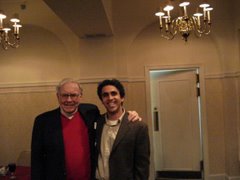Mohnish Pabrai hosted his second leg of his annual meeting on September 27 in Chicago. Each year, Pabrai holds two meetings - one in Chicago and the other in Huntington Beach, CA to accommodate the geographic disbursement of his investor base.
The meeting began with Pabrai going over the past performance:
1. Since the 1999, the annualized return has been over 29% after fees.
According to data from Lipper, this performance ranks the Pabrai Investment Funds number 3 out of some 4,000 mutual funds during this eight year stretch.
The mutual fund comparison is appropriate because although Funds are legally structured as limited partnerships, consider that:
1. The Funds only take long positions in publicly traded securities - no shorting
2. No leverage (although in the past, a little margin was used during times of plenty at cheap prices)
Sitting Still Can Be Profitable
Buffett used to compare his investing to a baseball player at bat. Unlike baseball, in investing, you have no called strikes. You can wait and wait until the fat pitch comes to hit one out of the park.
Most market participants mistakenly assume that they will be penalized if they don't pull trigger and buy something (who wants to be sitting still when the Dow is up 400 points in a day?).
Let me now give you Sham's Theory on Investing (quite basic as I don't do well with complex situations):
There is no way that you will lose any money if you just sit still and do nothing. Wait for Mr. Market to serve you instead of guide you.
The above statement presents two takeaways:
1. The "price is what you pay/value is what get" concept. As Ben Graham alluded, every stock is a good investment at one price. One has to be patient and disciplined not to overpay. A good company (Google) is not necessarily a good investment ($500+ per share, over 40x P/E, etc.).
2. Be willing to watch your investment decline by 50% and sit still....or buy more. Buffett once remarked that you should be able to see your investment decline by half and have the conviction to buy more if your analysis and reasoning are right. (Remember that I am implying that nothing has occurred to change the intrinsic value - and that you would have caught such a deterioration way before such a drop).
Indeed the Pabrai Funds experienced such a situation and Mohnish discussed the issue at length:
Several years ago, Pabrai experienced a multi month time period during which the net asset values of his fund were down by more than 30%. Stocks he had bought were down by 40, 50 or more percent. According to Mohnish, this was not a hypothetical situation. There were some investors who literally entered his Fund right before the decline and they received statements indicating that their investments were down by over 30%.
There was no specific reason for the decline. The businesses were still intact. There was no direct correlation in the fund's holdings. There was no particular sector or industry weighting on the portfolio. Each company operated in a different industry, with a different set of economic considerations. What had happened was that the Dow Jones average had dropped from around 10,000 to 7,000.
Sometime during this situation, many investors would have gotten out at a decline of 10-15% giving no second thought to the fundamental soundness of the individual businesses.
Once the paper loss is realized, the investor is focused on recouping the loss quickly, an process that often ultimately leads to a less prudent investment approach.
Pabrai discussed the individual investments during that time, his cost, where they stood during the market decline, and ultimately where they stood when he exited.
In the end, the stocks recovered, some doubling and tripling the investment return.
As Mohnish responded to one question about his day to day activities:
"I consider myself a gentleman of leisure. I go into the office with no set goal of buying or selling. I just wait for something to grab my attention."
And that's all that needs to be said. The results speak for themselves.
The rest of the meeting Mohnish spent answering questions and as usual, there was no discussion on any current or potential investments.
Tuesday, October 9, 2007
Subscribe to:
Post Comments (Atom)


1 comment:
"There is no way that you will lose any money if you just sit still and do nothing. Wait for Mr. Market to serve you instead of guide you."
I fully agree with the sentiment expressed in the last sentence but the former I question, especially if one is still investing peanuts.
The cost of missed opportunities, while it doesn't show up as a negative, is a real one--and this is especially true if one is holding cash in an ever-declining currency.
Buffett himself acknowledges that he's made many errors of omission over the years. Perhaps that's to be expected, though, given the approach he has, which focuses first on not losing money.
(Any person who has not made many errors of omission has probably made many, many errors of commision!)
All this is not to say that every pitch should be swung at. Only those "fat pitches" should. But, especially for us--who are managing relatively small amounts of money--there are plenty of opportunities that Buffett et al can't take advantage of.
For anyone with less than 100 million to invest, I see no reason to hold significant amounts of cash with the amount of value that exists in certain small-cap and large-cap stocks now. Again, especially if one is holding cash in US dollars.
In this last scenario, one is most certainly losing the purchasing power of their money at a decent pace--as measured in other currencies, aside from the Zimbabwean dollar, or basically every tangible asset there is, aside from housing in the US.
Post a Comment